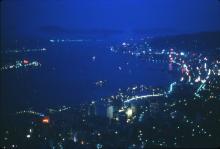West Brother Island Graphite Mine [????- ]
Primary tabs
This brief history of the West Brother Island (Tai Mo To) Graphite Mine does not attempt to cover the geology or mineralogy of the island or mine, nor details of the mine workings. For a much fuller account, which includes this information plus photographs, plans and further references, try The Geology and Exploitation of the West Brother Island Graphite Deposit as shown in Source 1 below.
An article in the SCMP on 5th August 1956 suggests that graphite was first discovered on the island by fishermen searching for “sandstone” to make grinding stones. Instead, they came across black material which they thought was coal. When this was analysed it proved to be graphite. This account possibly ties in with another which suggests that geological research intensified in the early 1950s resulting in the discovery of graphite in 1953 on West Brother island. (However this latter year of discovery is clearly wrong as mining had already started by then.)
The Tin Bo Mining Development Corporation commenced underground mining operations in late 1952. However, very soon after there was either a change in ownership or the name of the company was changed, as all subsequent records give the name of the Ng Fuk Black Lead Mining Company Limited.
(There is a contemporary company Tin Bo Trading (Hong Kong) Company, with an address in Sai Ying Pun which lists “metallurgy, mineral + energy” as part of its business scope. There appears to be very little information about Ng Fuk Black Lead Mining Co. Ltd. except that the company was registered on 16th July 1952 and then ”dissolved” on an unknown date.)
Primitive mining techniques were used:- manual extraction using picks and chisels, candles to provide light underground at regular intervals and timber props. The ore was hauled to the surface in baskets, presumably by hand. It was then carried to one of the two drying grounds where it was hand-sorted and dried in the open. Natural ventilation underground was sufficient initially because of the numerous tunnels and shafts.
Later, a power house was built to provide electricity for underground lighting, pumps for removing water, for electric hoists and for compressors.
At first all the ore was exported to the UK, but by 1955 the majority of the graphite was being sent to the USA, 1,200 of the 1,500 tons extracted in that year. It appears that most of this was used in control rods for nuclear power stations which were starting to operate around this time in both countries.
By the late 1950s annual production was between 3,000 and 3,500 tons. This rate continued into the early 1960s. By 1964 the mine workings had been considerably extended both laterally and to a depth of 90m below sea level. As a result continuous pumping was required to keep these lower workings dry and flooding became a possible hazard. Furthermore air compressors were needed to maintain sufficient ventilation in certain sections of the workings. By 1971 mining was terminated as these expensive measures were deemed to be uneconomic.
The mining licence expired in January 1973.
A Geological Society of Hong Kong newsletter report of a field trip to the Brother islands on 4th October 1992 says that on West Brother island there were remains of the mine jetty. The mine was “largely overgrown” but the old spoil heaps were easily identifiable but difficult to access.
West Brother island was levelled in the mid 1990s during construction of Chek Lap Kok. This resulted in the destruction of all the mine buildings and the spoil heap. At least some of the deeper workings must remain though permanently blocked off.
Sources
1. http://www.geolsoc.org.hk/_newsletters/Newsletter%201991%20Vol.9%20No.2.pdf
NW Woods & RL Langford The Geology and Exploitation of the West Brother Island Graphite Deposit The Geological Society of Hong Kong Newsletter Vol 9 No. 2 pp 24-35 (1991)
2. Sewell RJ, Tang DLK, and Shaw R, Hong Kong Geology, CEDD, Gov of HKSAR, 2009
3. W Jones Dictionary of Industrial Archaeology Sutton Publishing, UK 1996
4. Szczepanik E, The Economic Growth of Hong Kong, Oxford University Press, 1958
5. http://www.geolsoc.org.hk/_newsletters/Newsletter%201992%20Vol.10%20No.4.pdf
Langford RL Farewell To The Brothers The Geological Society of Hong Kong Newsletter
Vol 10 No.4. pp17-19 (1992)
6. http://www.cedd.gov.hk/eng/publications/geo/doc/HK%20Tunnel%20Cat.pdf

